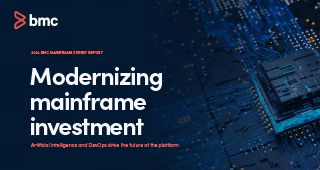The IT industry is constantly changing, developing, and improving. As IT professionals on the cutting edge of tech innovation, we also need to adapt, become agile, and keep up. Our customers look to us and our solutions to help them pilot their enterprise through the digital ocean. So, what’s driving this continuous evolution?
Every year, the British Computer Society produces The IT Leaders’ Report, which is similar to our own Annual Mainframe Survey, but with a wider, more generic scope, and a singularly British take. In the latest edition, UK IT leaders across industries were asked to choose their top five priorities. I wondered how the trends had changed over the past few years, and by how much, so I collected the data from 2014 to 2020.
Around 300 IT leaders were asked what their top 5 priorities were. In 2020, 52% put Security as one of their top 5, 52% put Cloud, 36% put IT governance, and so on.
| IT Trend | 2014 | 2015 | 2016 | 2017 | 2018 | 2019 | 2020 |
|---|---|---|---|---|---|---|---|
| Security | 53 | 60 | 59 | 66 | 48 | 52 | 52 |
| Cloud | 49 | 55 | 48 | 47 | 40 | 53 | 52 |
| IT governance | 0 | 0 | 33 | 38 | 28 | 34 | 36 |
| Automation | 0 | 0 | 0 | 0 | 26 | 36 | 32 |
| Everything-as-a-Service model | 0 | 0 | 0 | 0 | 31 | 31 | 31 |
| Agile | 27 | 22 | 26 | 28 | 27 | 34 | 29 |
| Mobile | 57 | 53 | 34 | 0 | 22 | 27 | 27 |
| Big data | 35 | 34 | 26 | 26 | 32 | 26 | 25 |
| Artificial intelligence | 0 | 0 | 0 | 8 | 18 | 21 | 21 |
| Data science | 0 | 0 | 0 | 18 | 17 | 22 | 20 |
| DevOps | 0 | 0 | 0 | 0 | 18 | 0 | 20 |
| Internet of Things (IoT) | 13 | 11 | 18 | 20 | 19 | 17 | 18 |
| Machine learning | 0 | 3 | 0 | 0 | 19 | 20 | 17 |
| 5G | 0 | 0 | 0 | 0 | 0 | 0 | 7 |
| Serverless architecture | 0 | 0 | 0 | 0 | 0 | 7 | 6 |
| Blockchain | 0 | 0 | 0 | 0 | 8 | 5 | 5 |
| Edge computing | 0 | 0 | 0 | 0 | 0 | 0 | 4 |
| Social media | 20 | 13 | 0 | 0 | 0 | 0 | 0 |
| Offshoring | 8 | 5 | 0 | 0 | 0 | 0 | 0 |
| Green IT | 7 | 7 | 6 | 5 | 0 | 0 | 0 |
| 3D printing | 0 | 1 | 0 | 0 | 0 | 0 | 0 |
| Augmented reality | 0 | 1 | 1 | 2 | 0 | 0 | 0 |
| GDPR | 0 | 0 | 0 | 0 | 23 | 0 | 0 |
| Accessibility | 0 | 0 | 0 | 8 | 0 | 0 | 0 |
Behind the numbers
Looking back across the past seven years’ results, we can observe a shift in priorities as fads changed and new technologies arrived.
- There were two unusual spikes in the data for accessibility in 2017 and GDPR in 2018, which could be related to businesses putting off regulatory changes until just before the deadlines.
- Social media was important in 2014 and 2015, and by the time everyone caught onto it, it vanished.
- Over the same period, offshoring was on everyone’s minds, but by 2016 the industry had caught up, so it also dropped off.
- Blockchain appeared in 2018, and quickly lost some of its audience’s interest, presumably due to the electricity cost (equivalent to powering all of Ireland) to support it. It’s still trundling along though, just in case.
- Recent addition IT governance suddenly appeared in 2016 and is not going away any time soon.
The Autonomous Digital Enterprise
In the report, data science, artificial intelligence, and machine learning are suddenly important growth areas, and DevOps, automation, and Everything-as-a-Service models have also become top agenda items. That’s not a surprise. They’re all key factors in the Autonomous Digital Enterprise (ADE), a forward-looking vision of the future state of business in which agile, customer-centric, insight-driven companies evolve their operations to drive innovation in the midst of persistent disruption. How does the data from The IT Leaders’ Report correlate to the ADE?
IT security
Adaptive Cybersecurity—developing security functions that can automatically sense, detect, and respond to access requests, authentication needs, threats from within and outside, and meet regulatory compliance—is one of the ADE tenets. Cyberattacks pose financial, reputational and regulatory risks to businesses, organisations and their customers. Little wonder, then, that security remains high in the priorities of UK businesses. 2019 saw some pretty startling data breaches by cyber criminals:
- Quest Diagnostics – 11.9 million records hacked
- Capital One – 100 million
- Dubsmash – 161.5 million
- Zynga – 218 million
- Moscow’s blockchain voting system was cracked a month before the elections
- Employees connect a Ukrainian nuclear power plant to the internet to mine Bitcoin
Governance
Regulation, legislation, litigation, and reputation are all part of the larger Adaptive Cybersecurity umbrella, too. They’re also words that bring horrifying feelings of FUD (fear, uncertainty, and doubt) to any executive, senior manager and auditor. Enterprises of all sizes should adhere to the rules and perform due diligence on all strategic decisions—financial, organisational, technical, and beyond.
DevOps, Agile, and Automation
I have bundled these together because they are closely related and interdependent. Enterprise DevOps—driving continuous improvement by pushing the principles of DevOps to surrounding processes—is another ADE tenet, and automation is at the heart of ADE, enabling businesses to concentrate more on the “where” and “when” of their mission and strategy than on the detailed minutiae and practicalities of “how.”
The principal principle of DevOps is, “Better Value Sooner, Safer, Happier.” And the Agile Manifesto’s four principles are, by now, ubiquitous and well-practised, though not without danger and disappointment if not practised SAFe®ly. (Pun intended. Other Agile methodologies are available.)
Digital business demands are driving accelerated development expectations with a push to deliver more faster than ever. Agile processes are driving an increased frequency and volume of change to Db2 databases, with a constant din of, “Is it done yet?” Operational performance and availability must continue with attention paid to whether anything else has been disrupted. And all of it is laid at the feet of an ever-depleting, experienced DBA workforce. An automated, resilient solution that embraces DevOps, Agile, and automation can help, providing speed and security to satisfy both Dev and Ops.
Cloud and Everything-as-a-service (XaaS)
Start-ups, subject matter experts (SMEs), and big businesses are all attracted to the cost-, space-, and effort-saving pay-as-you-go model of the cloud. Hand-in-hand with cloud services, the XaaS model is just as convenient and crucial in the eyes of IT leaders and shapers, enabling businesses of all sizes to adopt a better, faster, safer response to customers’ needs.
There are a wide range of services available, including (but not restricted to) Software as a Service (SaaS) apps in the cloud, Platform as a Service (PaaS) for development environments, and Infrastructure as a Service (IaaS) for virtual data centres. XaaS is a critical ADE enabler that delivers tailored, responsive, open (API-type) products controlled by customers and driven by their customers’ requirements.
Artificial intelligence and machine learning
Artificial intelligence and machine learning (AI/ML) and its integration into processes that work with—not instead of—humans is also integral to ADE, driving better and faster decisions across all business areas to provide predictable and transparent insight into the mainframe environment. If you haven’t got a strategy for AI/ML, you haven’t got a strategy at all.
Conclusion
Data science, IoT, and edge computing are also things to keep your eye on in the future, and indeed the present. BMC has a range of solutions that leverage the emerging technologies covered here, address top IT business concerns, and help evolve your business toward becoming an Autonomous Digital Enterprise.
Contact us for more information.







